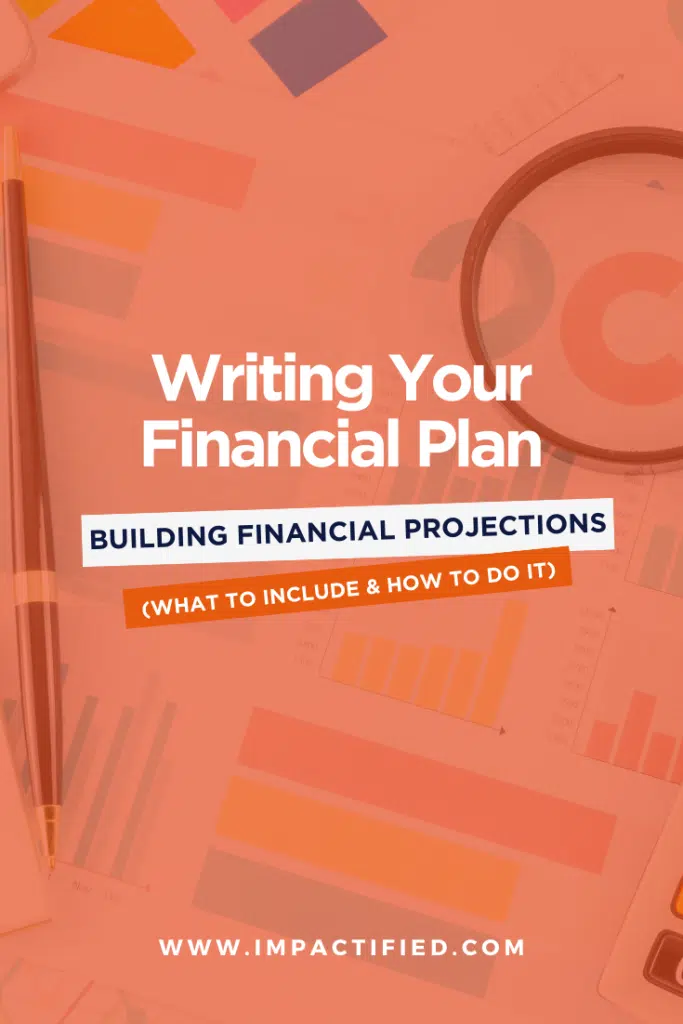So, you’ve decided to write a business plan? Good for you! It’s an important document that will help you outline your business goals, strategies, and tactics.
But it’s not just a document for you, as the business owner in charge of everything – it’s also important for potential investors and lenders.
In particular, one of the most important sections of your business plan should be your financial plan or, in other words, your overall financial projections for the next few years – understand, three to five years – distilled in a specific and highly codified format.
Why? Because the financial projections in a business plan are the numbers’ version of your pitch – if something doesn’t add-up, that’s where you see it.
Now, we know that numbers can be impressive (not to say daunting), so in this post, we’ll explain to you how to write a financial plan in your business plan.
We’ll also explain the logic you are supposed to follow to do things right (because financiers expect you to follow a very specific logic).
And we’ll explain what your business plan absolutely needs to include from a financial standpoint.
If that makes sense to you, then let’s get going!
By the way…
Before we dig into the financial projections’ discussion, let us give you a tiny bit of background!
We are professional business coaches, and our job is to push entrepreneurs and business owners to their next steps.
Business planning and business plans are part of that, obviously, therefore we have written a series of free articles on how to write a business plan – of which this page is a part.
We are on a mission to make entrepreneurship fun and accessible, so we provide about 80 percent of our content for free – including a free business plan template to be downloaded down this page.
Still, in case that’s not sufficient, we’ve also created our Business Plan Builder Module, which has been designed to make your life super easy.
Shameless plug: it gives you access to:
- a complete and solid business plan writing work-frame tool
- automated financial tables that take the hassle away (yayyy!)
- two designer-made templates (comprehensive + pitch deck)
- and two hours of tutorial videos recorded with a business coach to explain all the logic you’ll need to master if you plan on writing a business plan that converts.
There’s simply no way to make things easier!
Now, having said that, let’s get going.
As a reminder, what is a business plan about?
To start the discussion, remember that a business plan is about much more than just numbers. As we’ve explained in our article What are Business Plans For?, the role of such a document is to show that beyond a nice business plan pdf nobody really cares about, you have a real business and a plan to get it somewhere.
First, a business plan’s purpose is to help you explain what your project is about. In that sense, the document you need to write should be written as a storytelling instrument, designed, and formulated to tell people a story they will want to read AND remember.
Second, it should give you a way to showcase your main business objectives for the next few years, as well as the strategy you will put into place to get there and deliver on your promises.
Third, your business plan should also provide a market analysis, and a description of your main target segment. That gives the reader a better understanding of your ecosystem’s potential, but more importantly the exercise forces you to look around, open your eyes and do some meaningful research.
You wouldn’t want to drive blindfolded, would you?
Of course, your document should also have a financial component – which is the topic of this article – and there the challenge is to ensure that your financial projections make sense, that they are clear, accurate and easy to follow.
Long things short, investors and bankers expect you to match a very specific business plan outline and format (there’s a code!) and you don’t have much wiggle room there – so be careful in your approach!
What is a Financial Plan & what should it include?
Now, let’s get into the core of this article: financial plans and financial projections. What are they, why are they important – there is a lot to explore.
First things first, what is a financial plan? How important is it in a business plan? And what type of elements is it made of? What are the projected financial statements you need to provide? Oh, and what do we mean by ‘financial projections’ in the first place, by the way?
What is the role of a financial plan in business plan?
A financial plan is the financial part of your business plan. Its purpose is simple: explain to the reader what should be the ins and outs of your project from a financial perspective, and help them see if their own business projections are aligned with yours.
On the one hand, the idea is to put numbers on your project, to make it tangible and show that your vision includes the end and the means.
On the other, it is also to show that you are capable of defending your big idea as well as the projected financials that need to come with it – something that many wannabe entrepreneurs are actually unable to do…
Oooopsies!
As a side note, and as silly as that might sound, this means that your business plan should include a lot more than just a financial plan and a smart cash flow projection!
That point brings us back to the one we made earlier when we said that a business plan should follow a specific structure (go read that article!), but we mention it again because we want things to be very clear: your business plan should be a matter of storytelling, not just a matter of financial projections!
Typically, we often see accountants work on business plans, and what they produce is rarely enough because they only deliver financial estimates that make no real sense to non-accountants (even less to the entrepreneurs at stake) and leave aside the rest of the topics – particularly the storytelling!
Said differently? The numbers are one aspect of the story, but you still have to come up with the pitch – which is where the rest of the business plan comes in handy.
Make sure to deliver an easy-to-read mix!
Your financial plan must provide your financial projections
To get into the technical part of the discussion, the financial plan in your business plan should include your financial projections, organized in a very formal format.
That makes two distinct points to consider!
On the one hand, you should be able to show with clear numbers what money should come in and when (that’s the income forecasts), for this year but also for the next, the ones after that for three to five years.
On the other, you should also be able to show what money needs to go out to make the business roll. What are the production costs, the fixed and variable expenses, the salaries, and of course the various marketing expenses needed to generate the development you are planning on getting to.
On that point, remember that your cost of client acquisition should also be part of the formalized projections – otherwise your numbers will be flawed (and doomed).
Ultimately, you need to be very clear as to when your new business (or existing business) should break even, as to when should profits be expected, as to when lenders and investors will get their money back, so forth and so on.
It must include specific financial documents people will expect to see
From a very formal perspective, you shouldn’t be trying to make one single projection sheet. Nope! Your readers will expect to see three important financial documents in the financial section of the business plan you will introduce to them.
- A profit and loss statement – also known as your P&L statement, or as an income statement
- A cash flow statement
- And a balance sheet.
First, the P&L table or income statement should show what money is expected to come in or go out, but it should also show if and when the business will make a profit or a loss, year by year, for the next five years.
The sales forecast and the operating expenses should be easy to understand at that stage, and you should also be able to provide your estimated gross profit, your gross margin, as well as your net profit and net margin.
In case you are wondering, your gross profit corresponds to your sales minus your cost of production. Your net profit corresponds to the gross profit minus all the remaining costs.
It’s okay to read that twice…
Not being profitable is also okay, by the way. That’s the game. However, you must be able to explain why you won’t be profitable in a given year, and how you plan on filling the gap in the bank – otherwise your business dies, right?
Second, the cashflow statement should explain your cash flow management strategy and indicate when you will need to fill the bank account in, and why.
For instance, important account receivables could justify a temporary cashflow need, but the gaps left from the previous years should also be visible. Obviously, the funding needs should also be there and aligned with the financial situation of the business.
Third, the balance sheet is a summary of the previous two tables, except that it shows the various elements in terms of assets or liabilities. For instance, the account receivables we mentioned just before would be an asset (because some money is owed to the business) while account payables would be a liability (since the business owes money to someone else).
Does all this sound a little complex?
That’s because it is.
No need to worry, though. We have you covered and will provide all the templates and tools you need further below. For now, just keep reading.
So, what’s the financial plan in a business plan for?
To conclude, the financial plan in business plan should act as a financial cartography of what you have in mind for that business of yours.
- The financial plan should illustrate the plan you have for the business in terms of numbers
- It should include precise financial projections of what you think can be achieved
- It should clearly illustrate your cashflow management strategy
- And it should summarize the information clearly
- All of this through highly standardized tables financiers will understand very easily
What documents should a financial business plan contain?
- A profit and loss statement – also known as your P&L statement, or as an income statement
- A cash flow statement
- And a balance sheet.
Getting your financial business plan right is a lot simpler than it seems
Now, when you’re pitching that business of yours to potential partners, investors or lenders, you’ll need to provide them with a series of financial statements.
Yet, how to produce those documents without jumping into a living nightmare? How to come up with cash flow projections that make sense instead of being purely random?
Word of caution: financial planning for businesses is typically complex.
The question is not only fair, but it is also super-duper common and literally blocks tons of entrepreneurs and small business owners on a daily basis.
Why?
Because financial planning for businesses is typically complex.
Because most people aren’t comfortable with numbers.
And because the vast majority of small business owners simply don’t know where to start.
That’s probably why you were looking for either a financial plan pdf template or an example of financial plan for small business owners a few minutes ago, isn’t it?
Typically, here is what happens.
Some try and do their best, but then they don’t feel confident with pitching and defending their financial analysis, so they keep delaying and nothing happens.
Others end up having recourse to external help, even though external business plan consultants usually aren’t a good idea at that stage.
And the rest gives up.
That’s a shame, especially if consider that financial planning for a small business and building a financial plan for a business plan are only a matter of having access to the right method and tools!
Yes, a big (big) part of the work is to guestimate, but the rest is about trusting the process with the right logic, method and tools – and there’s nothing you can’t manage here.
Especially with the right tools!
How to build your financial forecasts?
Now that you understand the different sections of a financial plan, let us talk about how to build financial forecasting.
In plain English, this part of the exercise is where you’ll estimate your company’s income and expenses for the next few years. Therefore, you should keep a few things in mind.
One, you need to have a good understanding of your business in order to create realistic forecasts.
Sounds silly? Maybe, but this is a mistake people make way too much, and when they fail at justifying their financial projections, everything else goes down.
Two, you absolutely want to make sure that your projections can explore various trends, i.e. your pessimistic, optimistic, and most likely scenarios.
- If everything goes extremely well, we’ll get there.
- If everything goes wrong, we’ll get there.
- But… we should reasonably expect to achieve this and that if we obtain the funding we need…
Can you see the idea?
Be sure to also factor in any potential changes or risks that could affect your business.
For example, if you’re expecting a new competitor to enter the market, you’ll need to account for that in your projections. By being realistic and accounting for as many variables as possible, you’ll give yourself the best chance of success so give it some thought!
Pragmatically, how do I come up with reasonable financial forecasts for my business plan?
It’s all a question of common sense, really.
- How much do you plan on selling?
- What are your short, medium and long term financial goals?
- What would be the cost of production?
- What margin does that leave you with?
- What fixed costs would you expect?
- How about variable costs?
- Have you included transaction fees and credit card fees in your costs?
- What is the cost of insurance premiums?
- Will there be any debt to repay?
- What type of budget do you need for marketing purposes?
- What is the cost of acquisition of the client?
- What operational margin does it leave before the taxman comes in?
- What kind of money do you need to meet your long term goals?
- Have you planned for any emergency fund at all?
Right, that’s a long list. But! Answering those questions should give you a strong basis to build financial projections that make sense, because that’s literally how you would read your income statement in the end.
If you were trying to translate boring numbers into a meaningful story, that’s exactly where you would start!
Again, we have you covered with all this.
If you are looking for a concrete and practical financial plan example, make sure to download our business plan template down the page. It will give you the basic pro forma financials you’ll need.
If you need to understand the logic behind the template and would rather use an automated spreadsheet to get everything done, however, then it’s time to stop struggling.
The Impactified Business Plan Builder will provide everything you need: the automated tables and two hours of business coaching videos designed to explain all the logic you’ll need – what are you waiting for?
Why Are Financial Projections so Important in the end?
So, overall, why is creating financial projections so important? Are there various types of financial projections anyway? There are several things to keep in mind here.
First, your financial projections are important because they give bankers and investors the numbers they need (to make an informed decision) in a format they expect to see.
Second, your projections show whether your strategy is aligned with the means at your disposal to achieve it and whether you are aware of the financial engineering required to make your business roll.
Third, and in a related way, forecasts will give you, as the entrepreneur in charge, an opportunity to show if you understand the business for real (or if someone else not present during the discussion wrote the plan for you).
All of these documents are important, but you (nobody else!) will need to be able to tell a story around them.
Investors aren’t just looking for numbers! They invest in teams and people before investing in projects, so they want to know that you understand your business and that you have a plan for the future!
So, make sure your financial projections are accurate and be prepared to answer any questions investors have about them.
Understanding the investment process
To understand how to handle the exercise properly, understanding the investment and funding process in general is important.
What do bankers and investors expect when they are looking at a business plan? How do they decide whether to invest or not? And how do the financial projections help them make that decision?
In short, investors are looking for a return on their investment. So, they want to know what they can expect to earn from their investment, and how that compares to the risks they’re taking.
Your projected income statement is important there, but so are your cashflow projections!
Your financial estimates should therefore show how your business will grow and what profits you’ll generate, both in the short-term and long-term. This information will help investors determine whether or not your business is a good investment.
In contrast, bankers have a much lower risk tolerance and are not interested in funding you – they lend money to those who have money to repay the debt (or some assets to engage as collateral in case something goes wrong). Hence, what they look for is not a high return on investment based on risk, but a repayment capacity based on predictability and wise financial management.
Said differently? You need to create financial projections that make sense and adapt your financial pitch to your audience accordingly.
Show investors that there is a great opportunity to make money at a later stage and show bankers you will be able to start repaying as soon as possible.
Again, if you need to explore the question of investors’ mindsets, we elaborate on that in our video module – it’s time to give it a try!
Business valuation and exit thinking
Last but not least, understanding the investment process means that you also need to start thinking in terms of valuation and exit.
Or, said differently, the financial plan in your business plan must lead you to think about what your business will be worth a few years from now, and about how you will be able to make money (for you and your investment partners) by selling it.
On the one hand, exit thinking relates to the idea that investors invest in a business with the expectation that the business will raise more money later on, at which stage a larger investor will come in and buy the existing investors out.
To make your investors some money, therefore, you have to start thinking in terms of exiting the business at some point – which means progressively turning the business into an asset that works on its own, for you and as much as possible without you.
This mindset is absolutely key – think about it!
On the other hand, the discussion leads us to think in terms of business valuation – understand, how much is the business worth, and how much could it be sold for.
That topic is probably getting too technical for this article’s discussion, so we’ll explore it in another post.
Meanwhile, make sure to listen to the exit & valuation video in The Business Plan Builder module. We explain all this and even go as far as giving you an automated valuation calculator in the financial tables part of the tool – again, you have no excuse!
Avoiding the typical mistakes small businesses make with financial planning
To finish with the discussion, what should you keep in mind if you wanted to turn your financial plan into an asset that generates money rather than frustration?
Like it or not, but small business financial planning isn’t an intuitive thing and people tend to make very typical mistakes you should avoid at all costs!
Know your business
First piece of advice, you really (really, really) want to know your business from every angle.
When you are writing the financial plan in your business plan, it’s important to remember that your projections should represent an estimate of future performance. That’s how investors and lenders will read your numbers anyway.
So, your financial projections and forecasts should be based on realistic assumptions and calculations that you should always be prepared to adjust as needed.
In order to make accurate projections, it is therefore extremely important to have a good understanding of your business and the industry it operates in. You should also consult with industry experts and other professionals who can help you make informed decisions about your business.
Do the exercise yourself!
When you’re writing your financial plan, it’s important to avoid making common mistakes. One of the most common errors is underestimating how much money your business will need to operate.
Another is to rely on business plan consultants to write your financial projections without being able to understand the numbers yourself. This can lead to mistakes if the numbers are incorrect, and it can lead to embarrassing ahem! moments if you can’t explain how this or that number ended up in the document.
The best way to ensure accuracy is to do the exercise yourself with the right tools in hand and the brainstorming support of someone you trust to challenge your thoughts and conclusions.
This can be done with your acting CFO or close financial advisor if you have one, or with a fellow entrepreneur if anyone around you has the right mindset to dig into the discussion with you.
Alternatively, hiring a business coach is another way to brainstorm and challenge yourself – follow the link to find out more about that.
Don’t be a tourist. That’s stupid.
Third piece of advice: don’t enter into a discussion with a potential partner as a tourist – this is stupid, and that could very well kill you.
We have seen countless entrepreneurs walk into a room (let alone into a large startup event) saying that they were raising money for their startup. Yet, more often than not, their financial targets are not set or beyond approximative, which means they can’t explain why they need money and how they are going to spend it.
When you do that, the only thing you do is be stupid and make sure everyone knows about it.
First, because they won’t take you seriously. Would you invest money into someone who can’t tell you how they’ll use it and with what return on investment expectations?
And second, because the people you talk to will most likely ask you to come back to them once you have more information to provide. Which either means “don’t come back before six months to a year” or “please don’t come back at all, I have better things to do with my time and more competent people to talk to”.
Don’t be a tourist or you’ll just burn yourself. That’s stupid.
Turn your numbers into a story
The fourth piece of advice is going to be a repeat from earlier, but it’s important so let’s be redundant.
Now that you’ve written your financial projections, it’s time to go beyond the numbers and start telling your business story. The financial plan in your business plan is a great place to start but remember that it’s just one part of your overall pitch.
You’ll also need to be ready to pitch your idea, product, or service, and be ready to defend your financial plan against questions from investors or lenders.
Think holistically and build a story people will want to listen to, remember and act on. Period!
TL;DR: Get your financial projections right!
Now that you understand the different components of a financial plan, it’s time to learn how to write it. The key to writing a good financial plan is to be realistic. Don’t make assumptions that are unrealistic or impossible to achieve.
Start by estimating your sales and expenses for the first year of business. Be as specific as possible, and remember to include both fixed and variable costs. From there, you can create a cash flow statement that shows how your business will generate and spend money over time.
The goal of a financial plan is to paint a realistic picture of your business’s financial future. So make sure to update your plan as your business changes and grows. With careful planning and accurate numbers, you can ensure that your business will be successful for years to come.
What should your business plan financial plan include?
- A profit and loss statement – also known as your P&L statement, or as an income statement
- A cash flow statement showing if your business plan financial projections are realistic
- And a balance sheet.
What is the purpose of your business plan’s financial projections?
- To how the plan you have for the business in terms of numbers
- To show a financial overview of what you think can be achieved, by when, with what means
- To show you have a cashflow management strategy that makes sense
- To show you understand the standardized expectations and know how to play by the book
- To show that, overall, your business proposal makes sense whatever the angle!
Need a reliable template and video tutorial to get your financial business plan & financial projections right?
It’s built around over 2 hours of explanatory videos and comes with everything you’ll need to:
- Figure out what you need to figure out – powerful, uh?
- Understand the business plan code!
- Write a top business plan – with just the right amount of words and pages!
- Build your financial estimates – with an automated financial projections template excel spreadsheet!
- Create a visually appealing pitch deck people will want to read thanks to our designer-made templates!
If you want to stop wasting your time, this is THE most simple business plan template, and you can’t afford to miss it!
Wanna’ start with something free? Our free business plan template is also here to help!












